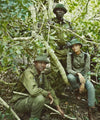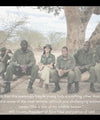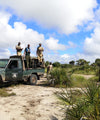My previous blog post was structured based on the daily routine during our days in the bush in 2018. Now I will take a slightly different approach – the post will have two parts. In part one I will share my impressions from the Walk With Rangers 2019, but this time mainly by sharing my pictures with you. The good thing is that we had many encounters with Kenyan wildlife, especially elephants – I am sure you will love the pictures.
Part two will focus on the Tana River Delta and the ranger team of Raabia Hawa, founder of Ulinzi Africa Foundation. Part two will give you some background information about the delta and the reasons why it needs Raabia’s ranger team on site.
Part 1
Preparation is key



Now some impressions from the walk










One of our camps




Part 2
About the Tana River Delta
The Tana River is Kenya's largest river. Its source is the Aberdare Mountains and the snow-covered peaks of Mount Kenya. Having travelled over nearly 1.000 km the river spreads out across a massive floodplain. It creates a maze of tidal creeks and mangrove swamps, salt marshes and palm islands. There are bush-covered dunes and grassland.
The Tana River Delta is one of the most important wetlands in Africa, one of the largest coastal delta ecosystems in Eastern Africa and has been described as Africa's second Okavango Delta. It covers an area of about 130.000 ha and consists of an impressive variety of freshwater, floodplain, estuarine and coastal areas with extensive mangroves, intertidal areas and pristine beaches, forming a large and very productive coastal ecosystem.
As a result, it was designated as Kenya’s 6th Ramsar Wetland of International Importance. The delta is rich in nature, supporting several highly threatened species of animals and plants, including five species of threatened marine turtles, the IUCN red-listed African elephant, and three species of monkeys like the critically endangered Tana River Red Colobus and the Tana Crested Mangabey. The delta is both, a breeding, and a feeding site for tens of thousands of birds. It is home to the endangered Malindi Pipit and the Basra Reed Warbler making it one of the key sites in the country for waterbird conservation.
It is one of the most intact forest ecosystems remaining in East Africa, with 60% of Kenya’s mangroves, coastal wetlands, coral reefs and beaches.
The delta supports over 100.000 people who practice pastoralism, agriculture and fishing, and depend on the delta’s ecosystem.
The main cultural groups in this landscape include Somali (Abdulla and Wardei) and Orma people who are semi-nomadic pastoralists. The Pokomo are living along the Tana River and the Tana Delta, farming in the more fertile riverine floodplains – most of the farmers in Tana River Delta belong to the Pokomo ethnic group. The Bajuni, mainly fishermen, live along the coast who also practice some subsistence agriculture. The Boni community who are few live mainly in settlements along the edge of the forest carrying out slash-and-burn agriculture.

About biodiversity
Landscape
The landscape covers parts of Lamu, Tana River and Garissa Counties. It includes the northern part of the East African Coastal Forest complex, an area considered one of the world’s top 25 biodiversity hotspots. It includes the indigenous dry coastal forests, adjacent forest-grassland mosaic, wetlands, coastal swamps, mangroves, beaches and coral reef ecosystems. All of them diverse and vast habitats that continue to support high numbers of wildlife, birds and marine animals. The Boni-Dodori forest system hosts fully functioning communities of predators and herbivores including endangered species like elephants and African wild dogs.
These forests are defined as dry coastal forest and are some of the largest intact and relatively undisturbed forests remaining in Kenya. The forest and adjacent forest-grassland mosaic contain numerous indigenous, endemic and threatened plant species rarely found in other forests.
Much of the landscape beyond these forests includes open-forest-savannah mosaic, Acacia bushland, characteristic grassland areas with doum-palms and wetlands. The Tana Delta – Kiunga coastline includes diverse and contiguous habitats of mangroves, beaches and dunes, coral reefs and deep waters of the offshore North Kenya Bank, which is probably the most valuable offshore fishery in Kenya. The 35.000 ha of mangroves includes the nine mangrove species found in the Western Indian Ocean. Mangroves in the Tana Delta-Kiunga are known to be superior in terms of biomass, height and basal areas. The Lamu archipelago mangroves alone constitute over 60% of Kenya’s mangroves, one of the largest stands of mangrove forests in East Africa. These mangroves combined with the nutrient rich colder waters are highly productive and support some of the highest densities of fish. The coral reef system which occurs at the convergence of the East Africa Coastal current and the Somali current, brings a unique mix of coral and fish species.
Mangroves
Mangrove ecosystems are one of the most valuable and productive coastal ecosystems and habitats for many plant and animal species and thus supporting the biodiversity in this region. They furthermore provide a wide range of ecosystem services. Mangroves provide fuel wood, timber, poles, charcoal, and non-wood products—such as food, medicine, and fish. As biomass they regulate the climate by binding and storing C02 (carbon sequestration).
Mangroves play a crucial role in the coastal flood risk reduction, protecting shores from storms and controlling erosion. Especially the fragile coral reefs depend on mangroves for survival. The flood impact experienced by villages unprotected by mangroves in 2013 in Kenya was 2.4 times greater than that of villages partially protected by mangroves and 14.7 times greater than that of villages completely protected by mangroves.
Similar results were shown in studies conducted after the 2004 tsunami in Thailand indicating that in areas with a healthy mangrove belt, only 7% of villages were affected with minimal damage in the villages. Meanwhile, areas with degraded mangroves experienced between 80% and 100% Damage.
Animals
The Tana River Delta is home for several endangered species from birds to mammals to corals, fish and turtles.
Surveys from 2012/2013 recorded 184 species of birds including two near-threatened species, the Southern Banded Snake Eagle and Fischer’s Turaco and confirmed the importance of the Boni-Dodori system to global and regional avian diversity including Palaearctic and European migrant birds and East African coastal biome bird species.
Aerial surveys of Lamu and southern Garissa Counties, showed this region holds the highest density of Reticulated giraffes, coastal topis and buffalos in Kenya as well as being home to most of the world’s remaining and critically endangered Hirola antelopes whose global population is estimated at 400-500 individuals.
17.000 ha on the east and west banks of the Tana River are home for the critically endangered Tana River Red Colobus and Tana Managabey as well as numerous other primates. These endangered primates exist in only a few small, fragmented forest patches along a 60 km stretch of the Tana River and occur nowhere else in the world. Their populations are estimated at between 1000-2000 individuals only.
The coastal waters in this area are home for the endangered Napoleon wrasse, the critically endangered knife-tooth sawfish and long-comb sawfish, several species of small coastal sharks and endemic corals not seen elsewhere in East Africa.
Five species of sea-turtles, (all classified as endangered or critically endangered), occur in Kenya’s waters. Three species are known to nest on beaches along this coast, the Green turtles, Hawksbill turtles and olive Ridley turtles while Loggerhead, and Leatherback turtles forage and migrate through the area. The most common species nesting on beaches in northern coastal Kenya are Green turtles, with occasional or very rare nesting by Hawksbill and Olive Ridley turtles.
Dugongs occur in the area, one of the last remaining populations in East Africa, although in very low numbers with possibly even fewer than 10 individuals. Dugongs are one of the most threatened mammals on the African continent.
Challenges
Despite the global recognition of this region as a biodiversity hotspot there has been relatively little conservation investment and little active management. The Reserves continue to be used by traditional communities, many of whom reside within their boundaries, for fishing, farming and livestock grazing without formal engagement of these communities in conservation and sustainable management of natural resources.
Land-rights and land-tenure continues to be an issue in Lamu County and this is inflamed by the presence of squatters and potential impact of large-scale national development projects including the proposed Lamu Port-South Sudan-Ethiopia-Transport (LAPSSET) corridor or the proposed Lamu coal plant. Emerging oil and gas exploration will further increase conflicts with traditional communities.
The poor infrastructure challenges the region as well – access to water, education and healthcare is limited. The road conditions and high cost of transport hinder most communities in getting their agriculture and fisheries products to markets.
Due to its remoteness and long-term insecurity of the area, the Boni-Dodori forest system has been little studied.
Security
Insecurity in Lamu, Tana Delta and Garissa counties is linked to the spill-over conflict from neighboring Somalia that has gone on for decades, as well as conflict over land tenure and property rights. (Community Land Act 2016). High levels of poverty, unemployment and a sense of neglect has enabled jihadist ideology from Al-Shabaab and involvement of youth in armed militias to gain ground.
Land conflict & Development projects
The enacted Community Land Act 2016 provides an opportunity for communities to secure ownership of their traditional land and the resources therein. However, the voice of communities has been marginalized in this region in the past, traditional ownership not always recognized, and corruption and land-grabbing has been commonplace. With high Population growth as well as an Influx of Immigrant Workers from outside the Region, the pressure on natural resources is rapidly increasing.
While such development projects need to go ahead for the benefit of the nation it is crucial that the potential environmental and livelihood impacts are mitigated, and local communities are empowered to have a voice over these issues.
Upstream hydrological changes such as damming and water diversions for irrigation and urban domestic water use have an impact of the flood dynamics of the Tana river. This impacts the regeneration and maintenance of the riverine forests.
Poverty
Tana Delta is one of the poorest regions in Kenya where 73% of people still live below the poverty line, and the river provides essential ecosystem services (e.g. food, fresh water and fuel) to 100.000 people living in the area.
The delta is the only dry season grazing refuge for local pastoralist communities (Wardei and Orma) who have used the land for centuries.
Illegal logging & charcoal
In my previous article I already explained the background of illegal logging and charcoal farming already, so I just list the main points below:
- Kenya loses around $10 million annually due to the illegal cross-border wood trade (WWF)
- Kenya loses 70.000 hectares of forest each year to illegal logging (UNEP)
- Charcoal is one of the biggest informal businesses in Africa – in 2012 Africa accounted for three-fifths of the world’s production (UN)
In Tana River Delta we see this as well, specific threats to the forests are primarily illegal logging of timber for building, especially hardwoods and mangroves, agricultural expansion and illegal settlements, resulting in clearing of forests and unsustainable farming practices such as slash and burn.
Traditional use of forest products is also becoming unsustainable as a result of increasing human-populations. Hardwoods are targeted for their timber for building, furniture and boat building as well as charcoal and include Mbambakofi, African blackwood, Muhugu, Mgurure, and Newtonia erlangeri.
Issuing permits provides a loophole that is exploited by local communities and traders, especially in the case of mangroves. Clearing of mangroves for development in coastal areas is increasingly becoming a concern.
Poaching/Fishing and the link to endangered species
When is a species endangered?
Established in 1964, the International Union for Conservation of Nature’s Red List (IUCN) of threatened species has evolved to become the world’s most comprehensive information source on the global conservation status of animal, fungi and plant species.
For further information about IUCN and its categories, please visit
iucnredlist.org In Tana River Delta wildlife populations are under threat from poaching for both game meat and trophies (ivory).
Bush-meat
Bush-meat traditionally formed a major part of the protein consumption for several communities in this area. Historically, subsistence bush-meat poaching would not have been a major threat to wildlife due to the relatively low human densities.
However, the increasing human populations, influx of migrant workers and the shift to commercialized bush-meat trade supplying both local centers and markets as far away as Mombasa, is now a major threat to wildlife.
Trophy hunting
Poaching of elephants for their ivory is still a threat, however, elephant numbers are very low (estimated less than 200 elephants in this region compared with 70.000 in the early 1970s).
Recent elephant surveys reported a carcass ratio of 21% (ratio of dead elephants to living elephants), suggesting that mortality rates continue to be higher than most other areas of Kenya and this is likely due to poaching.
Overfishing
Beside bush meat, fishing is also a major part of the protein consumption in this area. But now marine resources are threatened largely by unregulated, destructive and illegal fishing practices. This results in the over-exploitation of inland reefs, habitat damage and subsequent decline of in-shore fish populations, which has a direct impact on the livelihoods and well-being of fishing communities.
Fisher catch rates and earnings are declining as human populations increase and greater pressure is put on marine resources. This is despite the significant increase in price over the past 10 years for some species including lobsters and shark-fin.
Meanwhile turtles are not only caught as by-catch in nets, but fishermen also target turtles by setting nets in known feeding areas. Collection of turtle eggs from nests also takes place.
Historically, fishermen would have been targeted dugongs for their meat, but the numbers of dugong are so low now that human-related deaths are likely only due to accidental by-catch in fishing nets.
Further human wildlife conflicts
The local people live by the seasons, adapting to the regular floods that keep the area productive through the year. The delta provides grass throughout the dry season for enormous herds of animals (335.000 cattle, 260.000 sheep, 360.000 goats, 57.000 camels and 19.000 donkeys) from a very wide area, which are the basis of survival for many thousands of people.
Those animals share the same grasslands as the wildlife in this area. Climate change is likely to be driving further degradation of the rangelands, with more frequent droughts, lack of rainfall and conditions that promote bush encroachment. This coupled with over-grazing of existing grasslands is likely to put greater pressure on the grasslands at the periphery of the Boni/Dodori forests as livestock moves into these areas in greater numbers and for longer periods in search for food.
These massive livestock herds displace wildlife into less productive parts of the landscape where there is insufficient water and food to sustain them. This insufficiency also leads to wildlife raiding farms and destroying crops, which is a threat to local families as food security solely depend on subsistence agriculture. Buffalo are responsible for most of the crop destruction in the region, followed by baboons, elephants and hippos.
In 2016 & 2017, conservancies reported 8 people were killed by wildlife, with a further 11 people injured most commonly by buffalos. Conflicts with buffalos and hippos at water points in the dry season are also common as availability of water is scarce and people, livestock and wildlife are dependent on the same water sources.
Livestock predation by hyena, lion and wild dog is also relatively common - all those points mentioned bear future conflict potential as the situation is getting worse.
Message/Sustainable Solution
Securing and protecting these habitats and the species they support needs to be a local, national and global conservation priority. This can be only done with local communities - in so called community conservancies recognizing the coexistence of people, their livelihoods and wildlife.
Community Conservancies as a ‘community-owned and community-run institution which aim to improve biodiversity conservation, land management and the livelihoods of its constituents over a defined area of land traditionally owned, or used, by that constituent community.
Those community conservancies will need help for that and therefor it is inevitable to have rangers in this area, guiding, empowering and educating the communities as well as protecting the rules, documenting the development, giving wildlife a voice and eventually achieving sustainable conservation.
This is where the ranger team of Raabia and her Ulinzi Africa Foundation steps in
The Ranger Unit of Ulinzi Africa Foudation
While writing this article it finally happened - I am very happy to share with you that the MOU between KWS (Kenya Wildlife Services) and the Ulinzi Africa Foundation for joint operations of KWS rangers and Raabia’s ranger unit was signed. The Ulinzi Africa Foundation is now one of only two organizations in Kenya that can operate independently. You can’t believe how proud I am of my friend Raabia – she was working for 8 years on this. This is a huge step for Raabia and the Africa Ulinzi Foundation!
After introducing the Tana Delta to you I also want to give you a glimpse about what is planned to improve the situation on site.
Lower Tana and Tana Delta Conservation Management Plan
The official approval of Africa Ulinzi’s Ranger unit is the beginning of a bigger plan which has been developed in accordance with the KWS Protected Area Planning Framework (PAPF). It contains 3-year activity projects and thus links the 10-year vision and the annual planning.
The Tana Delta Conservation Management Plan is based on four Mgt. Program’s visualized below :
1. Ecological Mgt. Program
It aims to ensure that the existing ecological components are conserved, and reduction of threats to the areas key ecological features are reduced.
Employment of ecological monitoring and environmental security by controlling and reducing the currently ongoing rampant destructive practices
2. Tourism development and Mgt. Program
Development of sustainable tourism that incorporates cultural, scenic and wildlife elements for enhanced awareness. Start of economic empowerment in the area
3. Community partnership and Conservation Education Mgt. Program
Enhanced support and participation of protected area-adjacent communities in conservation and tourism.
Implementation of community barazas and workshops to uplift community enterprise, conservation education, human wildlife casualty reduction and mitigation, and promoting conservation compatible community land uses and practices
4. Protected Area Operations and Security Mgt. Program
Ensuring the baseline security status is established and maintained in order to support the implementation of other programs mentioned above.
Establishing effective management and reporting systems, improving performance and motivation of staff, improving facilitation, mobility and communications to support protected area management and eventual tourism development.
Enhancing security for wildlife, community and visitors alike
This should be enough for the beginning - I will promise to keep you updated or even better to let Raabia update you in this blog.
Best regards,
Steffen























5 comments
fixtjmggqm / Mar 28, 2021 at 08:31
Muchas gracias. ?Como puedo iniciar sesion?
ZNXdaCrzoFu / Aug 18, 2020 at 06:19
xTXvSkNsKYPZHlL
LGiJqgnay / Aug 18, 2020 at 06:19
ZAdYtCkPvEXKr
SfDlwUZuy / Jul 28, 2020 at 16:06
eBGofDgvXRjP
lyAIZODjqsX / Jul 28, 2020 at 16:06
vqQeWcSMxUJdp